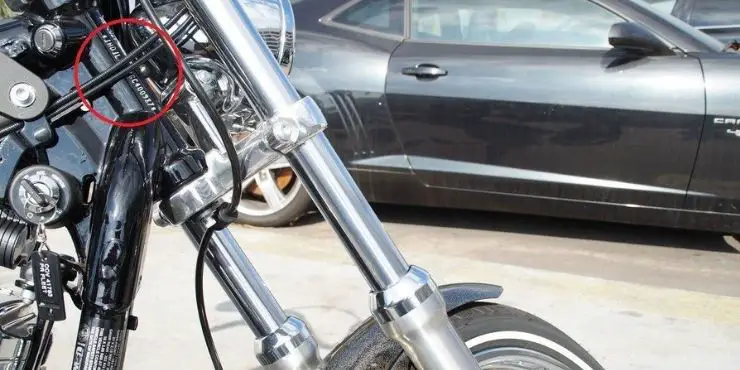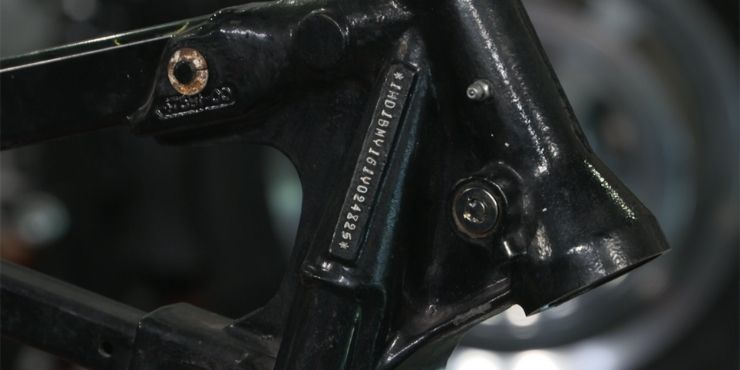Have you ever wondered what exactly does VIN number means? If so, then you’ll have a thorough understanding of the VIN number concept by the end of this article.
Harley-Davidson VIN numbers can be read by identifying key sections: the first three characters identify the manufacturer (1HD for Harley), the next five represent model and engine type, the ninth is a check digit, the tenth is the model year, and the last six are the serial number.
In this article, you will get to know all about VIN numbers, how to identify them, and how to read Harley VIN numbers. Continue reading to know more.
What are VIN numbers?
The VIN or Vehicle Identification Number is normally located on the headstock, below the handlebars. Sometimes, it is also present as a VIN sticker located on the front frame down tube. But what does the VIN number mean in a Harley-Davidson bike?
The VIN or Vehicle Information Number is a 17 character long number that contains the history of your motorcycle. While this isn’t something that you should memorize, it is still important to know where it is located. By knowing the VIN, you will know a lot of information about your bike. For starters, it is the identification of your bike. While you might not always carry the insurance card or the registration papers, your VIN will always be with you. Here are some situations where knowing your Vehicle Identification Number will save you time.
- If you’re purchasing a bike and you want to know its history.
- If you’re selling the bike, the buyers will want to know more about it. They can use the VIN to learn if the bike had any accidents, got stolen, or has been rebuilt.
- The sales representatives will likely ask for the VIN when you’re buying new parts.
Decode Harley-Davidson Vehicle Information Number
When decoding the Harley-Davidson VIN, it isn’t hard to decode it as long as you know what you’re looking for. The VIN is a line of characters, letters, and numbers divided into 3 sections. The first three characters will represent the World Manufacturer Identifier. Meanwhile, the next six characters will be the Vehicle Description Section, detailing the vehicle attributes from the bike manufacturer. The last eight characters will be the Vehicle Identifier Section, which shows the time and origin of manufacturing, and the serial number.
The VIN will feature numbers 0 through 9 as well as letters A to Z. However, the letters I, O, and Q have been removed to avoid any confusion with numbers 1 or 0. There will be only characters ad numbers used. Moreover, there will be no spaces between them. This breakdown will show you what the different characters stand for –
- The first character will tell you the country code
- The second character will tell you the manufacturer code
- The third character will tell you the vehicle type (Harley-Davidson bikes typically have “1” or “A”)
- Characters four through nine will help you identify the engine time, the engine size, and the model, with the 9th character being an accuracy check
- The tenth character will tell you the year code
- The eleventh character will tell you the factory code
- The twelfth through seventeenth characters will tell you the serial numbers
You can always request the VIN check through the department of motor vehicles to know your bike’s previous accident history. The VIN decoder is a website/tool that will help you receive the code. It will take each symbol search its meaning in the database, and give you the answer. In case any symbol in the code isn’t present, the decoder will skip it and proceed to the next character. The law requires all motorcycle manufacturers to use a single standard to generate VIN codes. This law is implemented on the territory of the United States.
How to read Harley VIN numbers?
Before 1961
Before 1961, for the Harley-Davidson models, the engine number would act as the VIN. This number was found on the left-side engine case. The Harley-Davidson models before 1969 didn’t carry any frame number. The way the VIN works for those models is –
- The first two numbers signify the model year
- The letters (up to four) will signify the model designation
- The last numbers will signify the production run number
Between 1962 and 1969
The VIN conventions during those years were –
- The first two numbers signify the model year
- The letters (up to four) will signify the model designation
- The last numbers will signify the production run number
Additionally, models having 4 digit productions numbers feature an even-numbered first digit for even years. Similarly, there will be an odd-numbered first digit for odd years. The models having a 5-digit production number will come with the first two digits even to signify even numbers. Meanwhile, there will be odd-numbered first two digits to signify odd numbers.
If the VIN doesn’t follow the even or odd sequence, then it’s almost a guarantee that it has been altered. It is fairly common to find mismatched engines in the early bikes having different VIN than the title paperwork. It is recommended that you should avoid such bikes.
Between 1970 and 1980
Beginning in 1970, Harley-Davidson started to stamp VIN numbers on both the engine case and the frame. The only exception was the 1979 model.
- The first two numbers will signify the model code
- The next five numbers (positions 3rd to 7th) will signify the production run number
- The last two digits will signify the designated year
The only legal VIN number for Harley-Davidson bikes produced after 1970 will be on the frame. It doesn’t matter if the engine number matches the registration papers. If the VIN on the frame doesn’t match the registration, you can get into legal trouble. You may be able to fool a few comes, but you will not be able to get away with it for long. Additionally, it needs to go without saying that any alterations to the VIN are illegal. This will apply for restamping frames or adding an original VIN to a replacement frame. If you’ve replaced the frame, you’ll have to get a new VIN assigned to your bike.
The infamous Harley-Davidson run of 1979
During the infamous 1979 model run, several Harley-Davidson bikes were produced that didn’t have engine numbers matching the frame number. The production date was reported to be between 1/9/79 and 2/7/79. The frame VINs affected were 43000H9 through 48199H9. The models featured engines numbered with a separate crankcase number instead of using the frame’s VIN. The engine number was reported to be a 10-digit numeric ID. It has been stated that Harley-Davidson decided to return to the old numbering sequence after realizing the legal ramifications.
1981 – Current
Starting in 1981, Harley-Davidson began using a 17-digit VIN number for the frame. Moreover, there was an abbreviated VIN present on the engine case. As always, the legal title needs to match the VIN number present on the frame. If the frame VIN and the title read differently, it would be invalid. If the title and frame read 1HD1ELK12BZ123456, the engine case needs to read something like ELKB123456.
Before 1970, the model year would appear in the last two digits of the VIN. Between 1970 and 1980, Harley-Davidson used an alphanumeric year code. The code “H” will be followed by the last number of the year. For instance, 1971 will be denoted by H1, 1972 will be denoted by H2, and so on. The only exception was 1980, which was J0. From 1980 to 2000, the single letter in the 10th digit was designated as the model year.
Between the years 1980 and 2000, alphabetical numbers were used for model numbers. It started with A for 1980 and ended with Y for 2000. After 2000, the character was changed from alphabets to numbers, with 2001 being denoted by 1, 2002 being denoted by 2, and so on.
Always consider the legal side of the Harley-Davidson VIN
When purchasing any used Harley-Davidson bikes, it is necessary to check the Harley-Davidson bike’s VIN numbers against the title. If the numbers don’t match exactly, then you should start looking elsewhere. Typographical errors on bike registrations are fairly common, but you shouldn’t take any chances. During some situations, a visit to your local department of motor vehicles would help you get the VIN typo corrected.
However, when you’re buying a bike with an out-of-state number, the difficulty in getting these errors corrected will drastically increase. With the strictness of the state regulations increasing each year, you should look to avoid such issues. Avoid them as you wouldn’t want to hold onto something that cannot be documented. Not only will the bike be illegal to drive, but you’ll be leaving yourself open to unnecessary problems. Someone can easily make a legal claim against your motorcycle and you.

If you’re having a Harley-Davidson engine with a matching title taken from a crashed or rebuilt motorcycle and put it into a new frame, then the VIN will be invalid. You may find someone who is trying to sell you a post-1970 Harley-Davidson bike where the title VIN matches the engine. But the VIN doesn’t match the number on the frame. In such situations, avoid the bike.
If you’re looking to upgrade your Harley-Davidson bike to a custom frame, you should apply for a new VIN. While it would be nice to have an original bike with matching engine and frame numbers, only the frame VIN will be relevant when considering legal registration.
You should never accept a Harley-Davidson bike or any other motorcycle without a legal VIN. If you’re not careful, you might end up losing your precious bike. Imagine a situation where you’re restoring a Harley-Davison bike originally bought without proper papers. Another party with a lawyer can come and claim that the bike belongs to them.
If you don’t have enough money to afford an attorney and lack any legal VIN or receipts, you would be forced to relinquish the bike. Although it might sound like extortion, this is a very real thing that happens quite often. You shouldn’t end up as a horror story. Take proper precautions when investigating the authenticity of the Harley-Davidson VIN and registration.
Conclusion
Thank you for reading. Hopefully, now you have a lot better understanding of the VIN numbers. Moreover, you will now know how to read Harley VIN numbers. VIN or Vehicle Identification is essentially a series of 17 characters that contains key information about your Harley-Davidson motorcycle. It will act as the legal identification of your bike. You should ensure that the VIN on the engine and the frame match; otherwise you could get into legal trouble.

